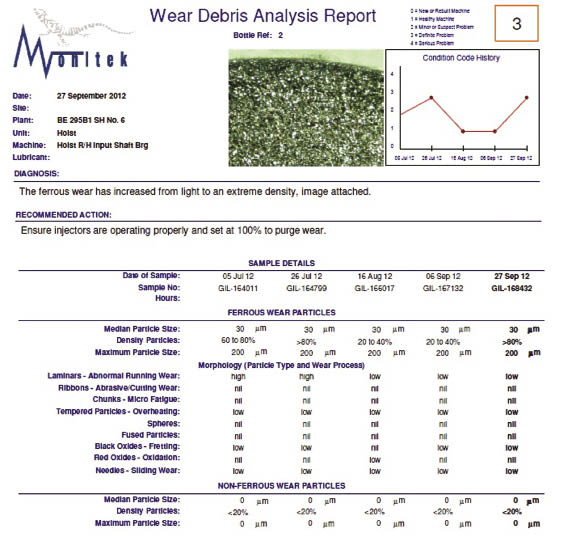Vibration sensors used to monitor bearings that spin at 10 rpm or more do a reasonably good job of listening for trouble. Such sensors are sufficient detecting problems in gears and bearings almost as the first wear appears. But what about bearings that barely move, such as pitch bearings? They don’t turn more than a few degrees, not enough to generate a signal. How can an O&M crew know the health of those?
Grease analysis is one way. Three locations on a turbine are candidates: Pitch and yaw bearings, and main shaft bearings on a few particular turbines.

The report was generated for critical hoist but a similar a report would be generated from grease from a turbine bearing. After two samples, often six months to a year apart, the lab can generate a trend line like that in the report’s upper right corner.
“Pitch bearings are good candidates for grease analysis because they do not move much, often just 10 to 15 degrees,” says Lee Byrum, Wyoming Area Manager for Monitek. Should a neglected bearing seize, the turbine may not be able to protect itself in high wind. In a worse case, it could lead to the destruction of the turbine. “Grease analysis is an excellent way of monitoring the bearing,” says Byrum. “To take a sample from a bearing, use an electrical cable tie and push it gently past the bearing seal into the grease. When you extract the cable tie, there will be lubricant on it,” she says.
Then, says Monitek Senior VP Ross Mackellar, “Put on some clean latex gloves, and transfer the lubricant from the cable tie into a clean sample bottle. Those used for oil samples will work. And about one-fourth of a bottle is sufficient.”
Take a sample from each pitch bearing, each in separate bottles. The bearing seals are usually pliable enough to allow slipping in a cable tie, but that really depends on the manufacturer. If you cannot, a bearing seal normally has a vent somewhere around the periphery. Remove the vent for access to the grease.
If you encounter a seal or design, that does not allow getting a cable tie into the bearing, it is permissible to collect grease that has seeped past the seal. However, this is less than ideal lubricant because grease that has seeped outside the bearing can collect external contamination.
The next location is the main rotor bearing and particularly on bearings with conventional configurations, those in which rotor shaft has an interference fit into the gearbox. GE and Siemens have used this configuration. Also, the V82 and V87 models from Vestas normally have two rotor bearings supporting the main-rotor shaft. The bearings are either in a single housing or two separate housings. The extraction technique is similar to the pitch bearing: Extract a grease sample from between the rollers and the same quantity.
Lastly, sample the yaw bearing. “Because the bearing is so larger, take samples from four different quadrants, one sample per quadrant. These can go into the same bottle,” says Mackellar. Normally, the yaw bearing is accessible from the yaw deck just below the nacelle.
Be sure to label the samples properly, with the field name, the turbine location in the field, such as W4 turbine, the point of grease extraction, the technician’s initials, and a date of extraction. It is not necessary to identify the brand of grease. Oils are a different matter so their analysis will need a manufacturer and brand.
After the lab receives the samples, analysis separates debris into ferrous and non-ferrous material, and it provides a commentary on morphology and density. “That information will come on a typical result sheet. We take a photo of what we see, and well send the photo of a patch test,” says Byrum. The lab does not comment on the chemical composition of the grease, only what it carries.
“We use the grease as a vehicle to carry the wear debris so its manufacturer or chemical composition is unnecessary,” she says. “We also use a magnetic technique to separate the ferrous material from the nonferrous. And it’s all hands on microscope and analysis work.” Byrum adds that the techniques used by Monitek’s lab have been developed over many years as a service center for the mining industry. WPE
Filed Under: Bearings, Featured, News





Slip ring is one of the important parts of the automation control system, and its performance is directly related to the stability of the whole system running
more information:http://www.moflon.com